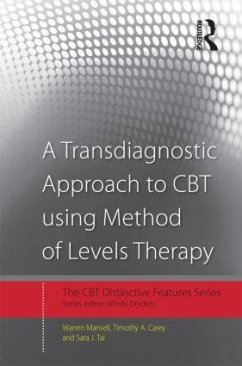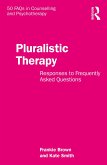Warren Mansell (UK University of Manchester), Timothy A. Carey (Centre for Remote Health, Alice Springs, Australi, Sara J. Tai (UK University of Manchester)
A Transdiagnostic Approach to CBT Using Method of Levels Therapy
Distinctive Features
Warren Mansell (UK University of Manchester), Timothy A. Carey (Centre for Remote Health, Alice Springs, Australi, Sara J. Tai (UK University of Manchester)
A Transdiagnostic Approach to CBT Using Method of Levels Therapy
Distinctive Features
- Broschiertes Buch
- Merkliste
- Auf die Merkliste
- Bewerten Bewerten
- Teilen
- Produkt teilen
- Produkterinnerung
- Produkterinnerung
The principles and techniques of PCT and MOL are clearly and practically described for clinicians to offer a transdiagnostic CBT that is tailor-made to the goals of each client.
Andere Kunden interessierten sich auch für
![Pluralistic Therapy Pluralistic Therapy]() Frankie BrownPluralistic Therapy34,99 €
Frankie BrownPluralistic Therapy34,99 €![Gestalt Coaching Gestalt Coaching]() Peter BluckertGestalt Coaching28,99 €
Peter BluckertGestalt Coaching28,99 €![Beck's Cognitive Therapy Beck's Cognitive Therapy]() Frank Wills (Independent Practitioner and UK Researcher)Beck's Cognitive Therapy25,99 €
Frank Wills (Independent Practitioner and UK Researcher)Beck's Cognitive Therapy25,99 €![Pluralistic Sand-Tray Therapy Pluralistic Sand-Tray Therapy]() Doreen FleetPluralistic Sand-Tray Therapy65,99 €
Doreen FleetPluralistic Sand-Tray Therapy65,99 €![Schema Therapy Schema Therapy]() Eshkol Rafaeli (Columbia University, New York, USA and Bar-Ilan UniSchema Therapy28,99 €
Eshkol Rafaeli (Columbia University, New York, USA and Bar-Ilan UniSchema Therapy28,99 €![Constructivist Psychotherapy Constructivist Psychotherapy]() Robert A. NeimeyerConstructivist Psychotherapy29,99 €
Robert A. NeimeyerConstructivist Psychotherapy29,99 €![Internet-Delivered CBT Internet-Delivered CBT]() Gerhard AnderssonInternet-Delivered CBT19,99 €
Gerhard AnderssonInternet-Delivered CBT19,99 €-
-
-
The principles and techniques of PCT and MOL are clearly and practically described for clinicians to offer a transdiagnostic CBT that is tailor-made to the goals of each client.
Hinweis: Dieser Artikel kann nur an eine deutsche Lieferadresse ausgeliefert werden.
Hinweis: Dieser Artikel kann nur an eine deutsche Lieferadresse ausgeliefert werden.
Produktdetails
- Produktdetails
- CBT Distinctive Features
- Verlag: Taylor & Francis Ltd
- Seitenzahl: 192
- Erscheinungstermin: 5. November 2012
- Englisch
- Abmessung: 185mm x 121mm x 15mm
- Gewicht: 192g
- ISBN-13: 9780415507646
- ISBN-10: 0415507642
- Artikelnr.: 35686656
- Herstellerkennzeichnung
- Produktsicherheitsverantwortliche/r
- Europaallee 1
- 36244 Bad Hersfeld
- gpsr@libri.de
- CBT Distinctive Features
- Verlag: Taylor & Francis Ltd
- Seitenzahl: 192
- Erscheinungstermin: 5. November 2012
- Englisch
- Abmessung: 185mm x 121mm x 15mm
- Gewicht: 192g
- ISBN-13: 9780415507646
- ISBN-10: 0415507642
- Artikelnr.: 35686656
- Herstellerkennzeichnung
- Produktsicherheitsverantwortliche/r
- Europaallee 1
- 36244 Bad Hersfeld
- gpsr@libri.de
Warren Mansell is a Reader in Psychology, Accredited Cognitive Behavioural Therapist, and Chartered Clinical Psychologist. He has authored over 100 publications on CBT and in 2011 received the May Davidson Award from the British Psychological Society for an outstanding contribution to the field of clinical psychology in the first ten years since qualifying. Timothy A. Carey is the Associate Professor in Mental Health at the Centre for Remote Health in Alice Springs, Australia. He has been using the Method of Levels in a variety of settings for over ten years and has researched and published extensively on its use. Sara J. Tai is a Senior Lecturer in Clinical Psychology at the University of Manchester, Chartered Clinical Psychologist and Accredited Cognitive Behavioural Therapist. She is an experienced researcher, practitioner, trainer and supervisor of Cognitive Behaviour Therapies, including the Method of Levels.
Introduction. Part I: Theory. Thinking styles and behaviours that maintain
psychological distress are transdiagnostic. Transdiagnostic processes
overlap to form a core process that maintains distress. The phenomenon of
control - perception, comparison, and action. The control of perception -
not the control of behaviour. The negative feedback loop. Basic causes of
the loss of control. Hierarchies of Control - Going up and down levels.
Conflict. Reorganisation - a non-linear process of change. Awareness and
imagination. Arbitrary (or inflexible) control maintains distress via
conflict. Directing awareness to regain flexible control - a common factor
of CBT, effective therapy, and natural recovery. Interpersonal control.
Circular causality and model building. It's all perception. Part II:
Practice. The setting conditions: A problem that the client is willing to
talk about. The stance: To enable the client's flexible control as
efficiently as possible. Method of Levels goal one: asking about the
current problem. Method of Levels goal two: asking about disruptions. Using
the past, controlling the present and living for the future. "Green Apples"
- Working through problems without disclosure. What to say at the first
session. How much treatment and how often to provide it. A focus on
distress rather than symptoms. Outcome monitoring. Evaluating your own
practice. The therapeutic relationship - liberated exploration. Building
MOL into other therapies and therapeutic practices. Utilising control
theory in existing CBT. Interventions without talking - testing the
controlled variable.
psychological distress are transdiagnostic. Transdiagnostic processes
overlap to form a core process that maintains distress. The phenomenon of
control - perception, comparison, and action. The control of perception -
not the control of behaviour. The negative feedback loop. Basic causes of
the loss of control. Hierarchies of Control - Going up and down levels.
Conflict. Reorganisation - a non-linear process of change. Awareness and
imagination. Arbitrary (or inflexible) control maintains distress via
conflict. Directing awareness to regain flexible control - a common factor
of CBT, effective therapy, and natural recovery. Interpersonal control.
Circular causality and model building. It's all perception. Part II:
Practice. The setting conditions: A problem that the client is willing to
talk about. The stance: To enable the client's flexible control as
efficiently as possible. Method of Levels goal one: asking about the
current problem. Method of Levels goal two: asking about disruptions. Using
the past, controlling the present and living for the future. "Green Apples"
- Working through problems without disclosure. What to say at the first
session. How much treatment and how often to provide it. A focus on
distress rather than symptoms. Outcome monitoring. Evaluating your own
practice. The therapeutic relationship - liberated exploration. Building
MOL into other therapies and therapeutic practices. Utilising control
theory in existing CBT. Interventions without talking - testing the
controlled variable.
Introduction. Part I: Theory. Thinking styles and behaviours that maintain
psychological distress are transdiagnostic. Transdiagnostic processes
overlap to form a core process that maintains distress. The phenomenon of
control - perception, comparison, and action. The control of perception -
not the control of behaviour. The negative feedback loop. Basic causes of
the loss of control. Hierarchies of Control - Going up and down levels.
Conflict. Reorganisation - a non-linear process of change. Awareness and
imagination. Arbitrary (or inflexible) control maintains distress via
conflict. Directing awareness to regain flexible control - a common factor
of CBT, effective therapy, and natural recovery. Interpersonal control.
Circular causality and model building. It's all perception. Part II:
Practice. The setting conditions: A problem that the client is willing to
talk about. The stance: To enable the client's flexible control as
efficiently as possible. Method of Levels goal one: asking about the
current problem. Method of Levels goal two: asking about disruptions. Using
the past, controlling the present and living for the future. "Green Apples"
- Working through problems without disclosure. What to say at the first
session. How much treatment and how often to provide it. A focus on
distress rather than symptoms. Outcome monitoring. Evaluating your own
practice. The therapeutic relationship - liberated exploration. Building
MOL into other therapies and therapeutic practices. Utilising control
theory in existing CBT. Interventions without talking - testing the
controlled variable.
psychological distress are transdiagnostic. Transdiagnostic processes
overlap to form a core process that maintains distress. The phenomenon of
control - perception, comparison, and action. The control of perception -
not the control of behaviour. The negative feedback loop. Basic causes of
the loss of control. Hierarchies of Control - Going up and down levels.
Conflict. Reorganisation - a non-linear process of change. Awareness and
imagination. Arbitrary (or inflexible) control maintains distress via
conflict. Directing awareness to regain flexible control - a common factor
of CBT, effective therapy, and natural recovery. Interpersonal control.
Circular causality and model building. It's all perception. Part II:
Practice. The setting conditions: A problem that the client is willing to
talk about. The stance: To enable the client's flexible control as
efficiently as possible. Method of Levels goal one: asking about the
current problem. Method of Levels goal two: asking about disruptions. Using
the past, controlling the present and living for the future. "Green Apples"
- Working through problems without disclosure. What to say at the first
session. How much treatment and how often to provide it. A focus on
distress rather than symptoms. Outcome monitoring. Evaluating your own
practice. The therapeutic relationship - liberated exploration. Building
MOL into other therapies and therapeutic practices. Utilising control
theory in existing CBT. Interventions without talking - testing the
controlled variable.








